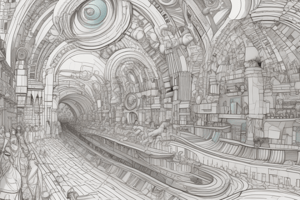Podcast
Questions and Answers
Which of the following is NOT an element of research design?
Which of the following is NOT an element of research design?
- Ethnography
- Trade-offs and Compromises (correct)
- Experiments
- Survey Research
What is the purpose of a research design?
What is the purpose of a research design?
- To conduct a research proposal
- To explain why a researcher might settle for less than the ideal research design
- To develop an appropriate research design for any given study (correct)
- To develop a problem statement
Which type of study setting involves minimal interference from the researcher?
Which type of study setting involves minimal interference from the researcher?
- Experiments
- Survey Research (correct)
- Case Studies
- Ethnography
What is the difference between cross-sectional and longitudinal studies?
What is the difference between cross-sectional and longitudinal studies?
What is the purpose of mixed methods in research design?
What is the purpose of mixed methods in research design?
What is the main objective of Lecture 5: Elements of Research Design?
What is the main objective of Lecture 5: Elements of Research Design?
Which research strategy involves observing and documenting the behavior of a group of people in their natural setting?
Which research strategy involves observing and documenting the behavior of a group of people in their natural setting?
What does the term 'unit of analysis' refer to in research design?
What does the term 'unit of analysis' refer to in research design?
What is the main difference between cross-sectional and longitudinal studies?
What is the main difference between cross-sectional and longitudinal studies?
What is the purpose of action research in research design?
What is the purpose of action research in research design?
Flashcards
Research Design
Research Design
The blueprint for your research, outlining how to collect and analyze data to address your research questions effectively.
Naturalistic Setting
Naturalistic Setting
The research setting where researchers observe behavior without manipulating variables, allowing for natural and realistic observations.
Cross-Sectional Study
Cross-Sectional Study
These studies gather data from participants at one single point in time, providing a snapshot of a situation.
Mixed Methods
Mixed Methods
Signup and view all the flashcards
Action Research
Action Research
Signup and view all the flashcards
Longitudinal Study
Longitudinal Study
Signup and view all the flashcards
Ethnographic Study
Ethnographic Study
Signup and view all the flashcards
Unit of Analysis
Unit of Analysis
Signup and view all the flashcards
Controlled Setting
Controlled Setting
Signup and view all the flashcards
Purpose of Research Design
Purpose of Research Design
Signup and view all the flashcards
Study Notes
Research Design Elements
- Elements of research design include defining the problem, selecting participants, and deciding on data collection methods.
- Specific components not considered part of research design may include peripheral tools or equipment unrelated to the methodology.
Purpose of Research Design
- Provides a structured plan for collecting and analyzing data.
- Guides the researcher in addressing the research questions effectively and efficiently.
Study Settings
- Naturalistic settings involve minimal interference from the researcher, allowing observation of behaviors in their real environment.
- This contrasts with controlled settings where the researcher manipulates conditions.
Cross-Sectional vs. Longitudinal Studies
- Cross-sectional studies examine subjects at a single point in time, providing a snapshot of data.
- Longitudinal studies track subjects over an extended period, offering insights into changes and developments over time.
Mixed Methods in Research Design
- Combines qualitative and quantitative research approaches to enhance understanding.
- Facilitates a comprehensive analysis by integrating diverse data sources and perspectives.
Lecture 5: Elements of Research Design
- Aims to clarify fundamental components and processes of designing research.
- Focuses on equipping students with the skills needed to create effective research strategies.
Observational Research Strategy
- Ethnographic studies involve observing and documenting behavior in natural settings without interference.
- Allows for rich, contextually grounded insights into group dynamics.
Unit of Analysis
- Refers to the primary entity being studied or analyzed, such as individuals, groups, or organizations.
- Crucial for defining what is being measured and understood in the research.
Purpose of Action Research
- Designed to address real-world problems while simultaneously contributing to knowledge.
- Involves practitioners in a cycle of planning, action, observation, and reflection to facilitate practical changes.
Studying That Suits You
Use AI to generate personalized quizzes and flashcards to suit your learning preferences.




